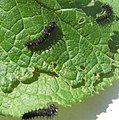Hyalophora cecropia
| Cecropia Moth | |
|---|---|
 | |
| Binomial: | Hyalophora cecropia |
| Family: | Saturniidae |
| Order: | Lepidoptera |
| Metamorphosis: | Complete |
| Damaging stages: | Caterpillar |
The caterpillars of the Cecropia Moth feed on a wide range of trees and shrubs. The adult is one of the largest moths found in North America, and females with wingspans that are 75 mm or more have been documented. It is found throughout the Eastern part of the continent, and as far west as the Rocky Mountains and north into the maritime provinces of Canada. The larvae of these moths are most commonly found on Maple trees, but they have been known to feed on Wild Cherry and Birch trees among many others.
Description
[edit | edit source]Caterpillars are dark-colored and hairy, adults a large moth.
Symptoms and Signs
[edit | edit source]Foliar damage may be severe if large numbers are present.
Ecology
[edit | edit source]
The life cycle of the moth is much like any other saturniidae species. It lays oval-shaped, light brown eggs on the leaves of the host plant. When the eggs hatch, small black and hairy caterpillars emerge (first instar), and eat their eggshells.Sometimes the newly hatched caterpillars have yellow bristles, which darken in a few minutes. As the caterpillars age, they molt 5 times. The second instar is yellow-green with black spots and spiny orange, yellow and blue knobs. The third and fourth instars have smaller spines, and are similar to each other. The fifth instar is a whitish color with bright yellow, blue and red knobs. The caterpillars feed heavily on their host plant and can grow up to five inches long. They then spin cocoons of brown silk, usually wrapped in leaves of the host plant. They then pupate inside the two-layered cocoon. There is only one brood per year, the cocoon overwintering and emerging in spring. When the adults eclose, they have to pump fluid into their wings to extend them. The females emit pheromones at night, which the male can detect with its large, bushy antennae. Males can fly for miles in order to reach a female. The moths mate, and the female spends the remainder of her life laying eggs, while the male may mate several more times. Because the adult moths do not have mouth parts they are unable to eat. As a result, the lifespan for an adult Cecropia moth is generally only 7 to 10 days in the wild, perhaps a little longer or shorter, depending on how much movement the moth makes. For instance, if temperatures are cooler, the moth may remain mostly inactive, which will increase its life. In captivity, this lifespan can be extended to about a month by placing the moth in the fridge directly after it hatches and its wings are dry. (Those who intentionally rear the moths may find this necessary to synchronize mating.)
Differentiating between genders of this species is very easy. The most obvious difference is the plumose antennae. Males will have a very bushy antenna while females will have a moderately less bushy antenna. Another difference is that the females will be slightly larger in the abdomen due to carrying eggs. Male's abdomens are also more angular than the female's abdomens which are more rounded.
-
Cecropia eggs
-
1st instar reared on Cherry.
-
Male Adult
-
Female Adult
Host plants
[edit | edit source]- Acer
- Alnus
- Betula
- Cornus
- Fraxinus (Ash)
- Juglans
- Malus
- Prunus
- Quercus (Oak)
- Salix
- Syringa (Lilac)
- Viburnum
Control
[edit | edit source]- Biocontrols (microscopic): Bacillus thuringensis can be applied to leaves where caterpillars are feeding.




